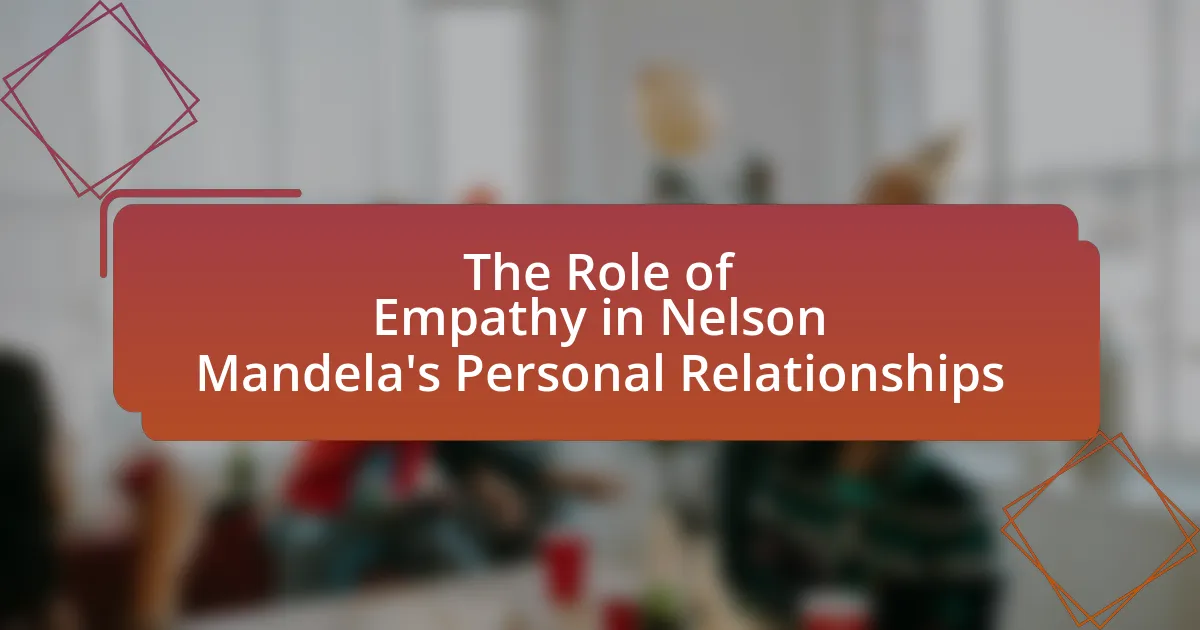The article examines the connection between Nelson Mandela’s leadership and the establishment of healthy partnerships, highlighting his emphasis on reconciliation, collaboration, and mutual respect. It discusses how Mandela’s leadership style fostered inclusivity and trust, exemplified by initiatives such as the Truth and Reconciliation Commission and the Government of National Unity. Key traits of Mandela’s leadership, including resilience and empathy, are explored, along with the importance of healthy partnerships in effective leadership and organizational success. The article also outlines practical strategies for leaders to emulate Mandela’s approach in building and maintaining strong partnerships.
What is the connection between Mandela’s leadership and healthy partnerships?
Mandela’s leadership is intrinsically linked to healthy partnerships through his emphasis on reconciliation, collaboration, and mutual respect. His approach to leadership fostered an environment where diverse groups could come together, exemplified by the establishment of the Truth and Reconciliation Commission in 1995, which aimed to heal the nation post-apartheid by promoting dialogue and understanding among conflicting parties. This initiative not only facilitated partnerships between former adversaries but also laid the groundwork for a more unified South Africa, demonstrating that effective leadership can cultivate strong, cooperative relationships essential for societal progress.
How did Mandela’s leadership style influence partnerships?
Mandela’s leadership style significantly influenced partnerships by fostering inclusivity and collaboration. His emphasis on reconciliation and dialogue encouraged diverse groups to work together towards common goals, exemplified by the formation of the Government of National Unity in 1994, which brought together former adversaries. This approach not only built trust among stakeholders but also created a framework for sustainable partnerships, as seen in initiatives like the Truth and Reconciliation Commission, which aimed to heal a divided nation through collective efforts.
What key traits defined Mandela’s leadership approach?
Nelson Mandela’s leadership approach was defined by key traits such as resilience, empathy, and inclusiveness. Resilience is evident in his ability to endure 27 years of imprisonment without losing sight of his vision for a democratic South Africa. Empathy is reflected in his understanding of the struggles of others, which allowed him to unite diverse groups under a common cause. Inclusiveness was a hallmark of his leadership style, as he actively sought to involve various stakeholders in the nation-building process, fostering collaboration and partnership across racial and cultural lines. These traits not only shaped his leadership but also contributed to the establishment of a more equitable society in South Africa.
How did Mandela’s values shape his partnerships?
Mandela’s values of equality, forgiveness, and collaboration significantly shaped his partnerships. His commitment to equality fostered inclusive relationships, allowing diverse groups to unite against apartheid. For instance, Mandela’s ability to forgive former adversaries, exemplified by his reconciliation efforts with the National Party, facilitated partnerships that transcended racial divides. Additionally, his emphasis on collaboration led to the formation of the Government of National Unity in 1994, which brought together various political factions to work towards a common goal of nation-building. These values not only strengthened his partnerships but also laid the foundation for a more cohesive and democratic South Africa.
Why are healthy partnerships important in leadership?
Healthy partnerships are crucial in leadership because they foster collaboration, trust, and shared vision among team members. Effective leaders, like Nelson Mandela, exemplified the importance of building strong relationships, which enabled them to unite diverse groups towards common goals. Research indicates that organizations with healthy partnerships experience higher employee engagement and productivity, as collaboration enhances problem-solving and innovation. For instance, a study by the Institute for Corporate Productivity found that companies with strong collaborative cultures are 5 times more likely to be high-performing. This evidence underscores that healthy partnerships not only strengthen leadership effectiveness but also drive organizational success.
What role do healthy partnerships play in effective leadership?
Healthy partnerships are essential for effective leadership as they foster collaboration, trust, and shared vision among team members. These partnerships enable leaders to leverage diverse perspectives and skills, enhancing problem-solving and innovation. For instance, Nelson Mandela exemplified this by building alliances across different groups in South Africa, which was crucial in uniting a divided nation and achieving reconciliation. Research indicates that organizations with strong collaborative cultures see a 5-10% increase in productivity, demonstrating the tangible benefits of healthy partnerships in leadership contexts.
How can healthy partnerships enhance organizational success?
Healthy partnerships enhance organizational success by fostering collaboration, innovation, and resource sharing. When organizations engage in effective partnerships, they can leverage diverse strengths and expertise, leading to improved problem-solving and creativity. For instance, a study by the Harvard Business Review found that companies with strong partnerships reported a 20% increase in productivity and a 30% increase in innovation rates. This demonstrates that healthy partnerships not only improve operational efficiency but also drive growth and adaptability in a competitive landscape.
What lessons can be learned from Mandela’s leadership regarding partnerships?
Mandela’s leadership teaches that effective partnerships are built on mutual respect and understanding. He demonstrated this through his ability to collaborate with former adversaries, such as negotiating with the apartheid government to achieve a peaceful transition to democracy in South Africa. This approach emphasized the importance of listening to diverse perspectives and finding common ground, which was crucial in fostering unity among different groups. Mandela’s commitment to inclusivity and dialogue is evidenced by his establishment of the Truth and Reconciliation Commission, which aimed to heal the nation by addressing past injustices through collective participation. These actions illustrate that successful partnerships require empathy, open communication, and a willingness to compromise for the greater good.
How did Mandela foster collaboration among diverse groups?
Mandela fostered collaboration among diverse groups by promoting inclusivity and dialogue. He established the Truth and Reconciliation Commission in 1995, which encouraged open discussions about past injustices, allowing various communities to share their experiences and grievances. This initiative not only facilitated healing but also built trust among different racial and ethnic groups in South Africa. Additionally, Mandela’s emphasis on unity and collective nation-building, as articulated in his speeches, inspired a shared vision that transcended divisions, further solidifying partnerships across diverse communities.
What strategies did Mandela use to build trust in partnerships?
Nelson Mandela built trust in partnerships through open communication, empathy, and shared goals. He emphasized dialogue, ensuring that all parties felt heard and valued, which fostered a sense of belonging and collaboration. Mandela’s ability to empathize with diverse perspectives allowed him to connect with various stakeholders, including political opponents, thereby creating a foundation of mutual respect. Additionally, he focused on establishing common objectives, aligning interests among partners, which strengthened their commitment to collective success. These strategies were evident during the negotiations to end apartheid, where Mandela’s inclusive approach helped unite different factions towards a common vision of a democratic South Africa.
How did Mandela address conflicts within partnerships?
Nelson Mandela addressed conflicts within partnerships by promoting open dialogue and fostering mutual respect among stakeholders. He believed that understanding differing perspectives was crucial for conflict resolution, often encouraging discussions that allowed all parties to voice their concerns and aspirations. For instance, during the negotiations to end apartheid, Mandela emphasized the importance of reconciliation and collaboration, which helped to bridge divides between opposing groups. His approach was rooted in the belief that constructive communication could transform adversarial relationships into cooperative partnerships, ultimately leading to a more unified society.
What impact did Mandela’s partnerships have on social change?
Mandela’s partnerships significantly advanced social change by fostering collaboration across diverse groups, which was essential for dismantling apartheid. His alliances with various political entities, civil society organizations, and international leaders mobilized resources and support for the anti-apartheid movement. For instance, Mandela’s partnership with the African National Congress and other liberation movements united efforts against racial oppression, leading to the eventual establishment of a democratic South Africa in 1994. This collaboration not only galvanized local support but also attracted global attention and pressure on the apartheid regime, demonstrating the power of strategic partnerships in achieving transformative social change.
How did Mandela’s partnerships contribute to the anti-apartheid movement?
Mandela’s partnerships significantly advanced the anti-apartheid movement by fostering unity among diverse groups and amplifying international support. His collaboration with organizations like the African National Congress (ANC) and alliances with trade unions and civic groups helped consolidate efforts against apartheid, creating a broad-based resistance. For instance, Mandela’s partnership with the South African Communist Party and various labor unions mobilized mass protests and strikes, which were crucial in applying pressure on the apartheid regime. Additionally, Mandela’s ability to engage with global leaders and organizations, such as the United Nations, garnered international sanctions against South Africa, further isolating the apartheid government. These strategic partnerships not only strengthened the internal resistance but also highlighted the global fight against racial oppression, ultimately contributing to the dismantling of apartheid.
What examples illustrate the success of Mandela’s partnerships?
Mandela’s partnerships with various leaders and organizations illustrate significant successes, particularly in the realms of reconciliation and nation-building. One prominent example is his collaboration with F.W. de Klerk, the last apartheid-era president of South Africa, which culminated in the peaceful transition from apartheid to a democratic government. This partnership was recognized with the Nobel Peace Prize in 1993, highlighting its global significance. Another example is Mandela’s alliance with the African National Congress (ANC) and international anti-apartheid movements, which mobilized global support and sanctions against the apartheid regime, ultimately leading to its dismantling. These partnerships not only facilitated political change but also fostered a spirit of unity and healing within South Africa, demonstrating Mandela’s effective leadership in building coalitions for a common cause.
How can leaders apply Mandela’s principles to develop healthy partnerships?
Leaders can apply Mandela’s principles to develop healthy partnerships by fostering inclusivity, promoting dialogue, and demonstrating empathy. Mandela emphasized the importance of collaboration and understanding diverse perspectives, which can be achieved by actively engaging stakeholders in decision-making processes. For instance, his approach during the negotiations to end apartheid involved listening to various groups, ensuring that all voices were heard, which led to a more unified and cooperative society. This principle of inclusivity can help leaders build trust and mutual respect among partners, essential for sustainable relationships. Additionally, Mandela’s emphasis on forgiveness and reconciliation can guide leaders in overcoming conflicts and building stronger alliances, as seen in his efforts to unite a divided South Africa.
What best practices can leaders adopt from Mandela’s approach?
Leaders can adopt several best practices from Mandela’s approach, including empathy, collaboration, and resilience. Mandela demonstrated empathy by actively listening to diverse perspectives, which fosters trust and understanding among team members. His emphasis on collaboration is evident in his ability to unite various factions in South Africa, showcasing the importance of building coalitions and partnerships for collective goals. Additionally, Mandela’s resilience in the face of adversity serves as a powerful example for leaders, illustrating the need to remain steadfast and committed to their vision despite challenges. These practices are validated by Mandela’s successful transition from apartheid to a democratic society, highlighting the effectiveness of his leadership style in creating healthy partnerships.
How can leaders cultivate empathy and understanding in partnerships?
Leaders can cultivate empathy and understanding in partnerships by actively listening to their partners and fostering open communication. This approach allows leaders to grasp the perspectives and emotions of others, which is essential for building trust and collaboration. Research indicates that effective listening enhances relational dynamics, as it encourages partners to express their thoughts and feelings without fear of judgment. For instance, a study published in the Journal of Business Communication found that leaders who practice active listening significantly improve team cohesion and satisfaction. By prioritizing these practices, leaders can create an environment where empathy thrives, ultimately strengthening partnerships.
What role does communication play in building healthy partnerships?
Communication is essential in building healthy partnerships as it fosters understanding, trust, and collaboration. Effective communication allows partners to express their needs, share ideas, and resolve conflicts, which are critical components of any successful relationship. Research indicates that organizations with strong communication practices experience 47% higher employee engagement, leading to more productive partnerships. Furthermore, clear communication helps to align goals and expectations, reducing misunderstandings and enhancing cooperation. Thus, the role of communication is foundational in establishing and maintaining healthy partnerships.
What common challenges do leaders face in forming partnerships?
Leaders commonly face challenges such as misaligned goals, communication barriers, and trust issues when forming partnerships. Misaligned goals can lead to conflicts in priorities, making it difficult for partners to work cohesively towards a shared vision. Communication barriers often arise from differing organizational cultures or practices, which can hinder effective collaboration. Trust issues may stem from past experiences or perceived risks, making it challenging for leaders to establish a solid foundation for partnership. These challenges are well-documented in studies on organizational behavior, highlighting the importance of clear objectives, open communication, and trust-building strategies in successful partnerships.
How can leaders overcome barriers to effective collaboration?
Leaders can overcome barriers to effective collaboration by fostering open communication and building trust among team members. Open communication allows for the sharing of ideas and concerns, which is essential for addressing misunderstandings and aligning goals. Trust is crucial as it encourages team members to engage fully and share their perspectives without fear of judgment. Research shows that teams with high trust levels are 50% more effective in achieving their objectives. Additionally, leaders can implement structured collaboration tools and regular feedback mechanisms to facilitate ongoing dialogue and ensure that all voices are heard, further enhancing the collaborative process.
What strategies can be implemented to maintain healthy partnerships over time?
To maintain healthy partnerships over time, effective communication is essential. Regularly sharing thoughts, feelings, and feedback fosters transparency and trust, which are critical components of any successful partnership. Research indicates that partnerships characterized by open dialogue experience higher satisfaction and longevity. For instance, a study published in the Journal of Social and Personal Relationships found that couples who engage in frequent and honest communication report stronger relationship quality and stability. Additionally, setting mutual goals and regularly revisiting them ensures that both parties remain aligned and committed to the partnership’s success. This strategy not only reinforces collaboration but also helps in navigating challenges together, further solidifying the partnership over time.
What practical tips can leaders use to emulate Mandela’s partnership-building skills?
Leaders can emulate Mandela’s partnership-building skills by prioritizing empathy, active listening, and inclusivity. Mandela demonstrated empathy by understanding diverse perspectives, which fosters trust and collaboration. Active listening, as practiced by Mandela, allows leaders to genuinely engage with others, ensuring that all voices are heard and valued. Additionally, promoting inclusivity by bringing together individuals from various backgrounds, as Mandela did during the reconciliation process in South Africa, strengthens partnerships and encourages collective problem-solving. These strategies are supported by Mandela’s successful efforts in uniting a divided nation, showcasing the effectiveness of these skills in building strong, healthy partnerships.




